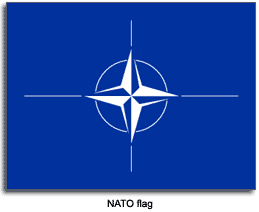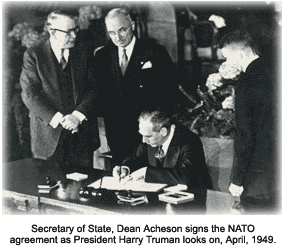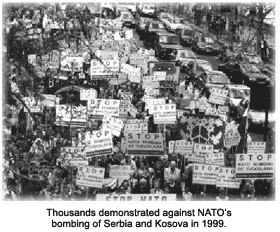NATO is based on the North Atlantic Treaty, which provides the organization a framework. The treaty provides that an armed attack against one or more of NATO`s member nations shall be considered an attack against them all.* NATO is headquartered in Brussels, Belgium. The organization was formed in 1949. Many nations joined NATO — even Iceland, the only member without a "typical" military force.
 Purpose & History of NATO
Purpose & History of NATO
The organization was originally formed out of the fear that the Soviet Union would ally militarily with Eastern European nations, i.e. the Warsaw Pact, and thus become a threat to Western Europe and the United States. In short, the alliance is an association of free states united in their determination to preserve their security through mutual guarantees and stable relations with other countries.
From 1945 to 1949, Europe faced the crucial need for economic reconstruction. Western European countries and their North American allies viewed with apprehension the expansionist policies and methods of the U.S.S.R. Having fulfilled their own wartime commitments, and desiring to reduce their defense establishments and demobilize forces, Western governments became increasingly alarmed as it became clear that the Soviet leadership intended to maintain its own military forces at full strength.
Furthermore, in view of the Soviet Communist Party`s avowed ideology, it was evident that appeals to the United Nations Charter, and international settlements reached at the end of the war, would not assure democratic states their autonomy. The rise of nondemocratic governments in many central and eastern European countries, and the resultant repression of opposition parties and basic human rights, raised more alarm in the West.
Between 1947 and 1949, a series of extraordinary political events brought matters to a head. They included direct threats to the sovereignty of Norway, Greece, Turkey and other countries, the June 1948 coup in Czechoslovakia, and the illegal blockade of Berlin that began in April of the same year. The signing of the Brussels Treaty in March 1948 marked the commitment of five Western European countries — Belgium, France, Luxembourg, the Netherlands, and the United Kingdom — to develop a common defense system and strengthen the ties among them in a manner that would enable them to resist ideological, political and military threats to their security. Later, Denmark, Iceland, Italy, Norway and Portugal were invited by the Brussels Treaty powers to become participants in that process.
Then followed negotiations with the United States and Canada on the creation of a single North Atlantic alliance based on security guarantees and mutual commitments between Europe and North America. The alliance would become the transatlantic link by which the security of North America was permanently tied to the security of Europe.
Negotiations culminated in the signing of the treaty in April 1949, entered into freely by each country following public debate and due parliamentary process. The treaty — a legal and contractual basis for the alliance — was established within the framework of Article 51 of the United Nations Charter, which reaffirms the inherent right of independent states to individual or collective defense. The treaty requires of each of them not to enter into any other international commitment that might conflict with its provisions. The preamble to the treaty states that the aim of the allies is to “promote peaceful and friendly relations in the North Atlantic area.”
 However, at the time of the treaty’s signing, the immediate purpose of NATO was to defend its members against a potential threat resulting from the policies and growing military capacity of the Soviet Union. The treaty created a common security system based on a partnership among the original 12 countries. Others joined later, with the current membership at 30 countries:
However, at the time of the treaty’s signing, the immediate purpose of NATO was to defend its members against a potential threat resulting from the policies and growing military capacity of the Soviet Union. The treaty created a common security system based on a partnership among the original 12 countries. Others joined later, with the current membership at 30 countries:
Security Tasks
The means by which the alliance carries out its security policies includes the maintenance of a sufficient military capability to prevent war and to provide for effective defense; an overall capability to manage crises affecting the security of its members; and active promotion of dialogue with other nations. The alliance performs the following fundamental security tasks:
A Continent Evolves
NATO has worked since its inception for the establishment of a just and lasting peaceful order in Europe based on common values of democracy, human rights and the rule of law. That central alliance objective has taken on renewed significance since the end of the Cold War because, for the first time in the post- World War II history of Europe, the prospect of its achievement has become a reality — as embodied by the European Union.
From time to time, the alliance met at the summit level with heads of state and governments participating. Their direct participation in the process of taking decisions by consensus, raised the public profile of such meetings and bestowed on them increased historical significance.
By 1991, the major transformation of international security at the end of the 1980s was dictating the shape of the new NATO that would emerge over the next few years. The first of a series of four summit meetings that would plot the course of the alliance’s adaptation to the coming decade took place in Rome in November 1991. It would be followed by another summit meeting in Brussels in January 1994, two further meetings in Madrid in July 1997, and in Washington in April 1999.
 Epilogue
Epilogue
The world has seen many changes since the inception of NATO. NATO peacekeeping forces maintain vigilance at hot spots around the world. Kosovo, Afghanistan and Somalia all enjoy a NATO presence. NATO announced on June 9, 2005, that it would help the African Union (AU) expand its peacekeeping mission in Darfur, Sudan, by airlifting additional AU peacekeepers into the region and assisting with training.
The following is from a speech by former NATO Secretary General Lord Robertson on November 12, 2003. The occasion was hosted by the George C. Marshall Foundation, the Center for Transatlantic Relations at Johns Hopkins School of Advanced Internationa Studies and the Royal Norwegian Embassy:
I am delighted to give my final speech in Washington as Secretary General at a venue named after the man who gave enlightened self-interest a good name. George C. Marshall, and the plan for which he is famous, rebuilt Europe and created the foundations on which the transatlantic partnership has prospered. But he did not do so out of pure philanthropy. American taxpayers bankrolled Europe`s reconstruction because Marshall and his colleagues recognized that it was in the interests of the United States for Europe to be strong and a close friend.Another excerpt from the same speech:
The power of self-interest was famously recognized by Lord Palmerston, the mid-19th century British Prime Minister, who said that countries have no permanent friends, only permanent interests. Today, the fundamental difference for both North America and Europe is that time, events and the efforts of people like George Marshall have given our respective interests such a degree of congruence and permanence that Palmerston would have found inconceivable.
The following is an illustration of how the world has changed. General Ray Henault of the Canadian Air Force accepted the chairmanship of NATO`s Military Committee on June 16, 2005, from his predecessor, General Harald Kujat — of the German Air Force. The Military Committee is the highest military decision-making authority in NATO, assisting and advising the North Atlantic Council. The Chairman of the Military Committee is selected by the Chiefs of Defense and appointed for a three-year term of office.